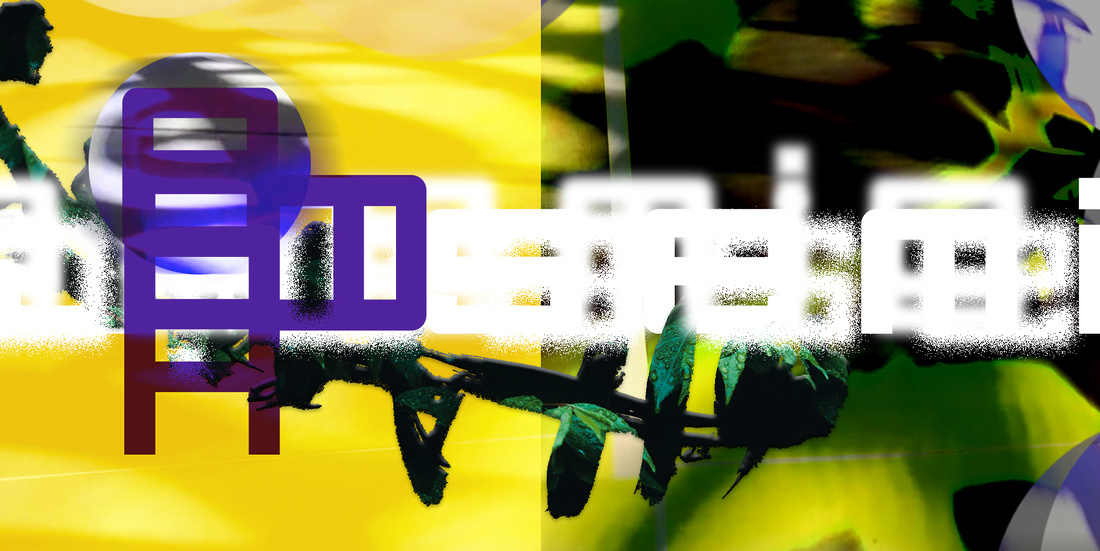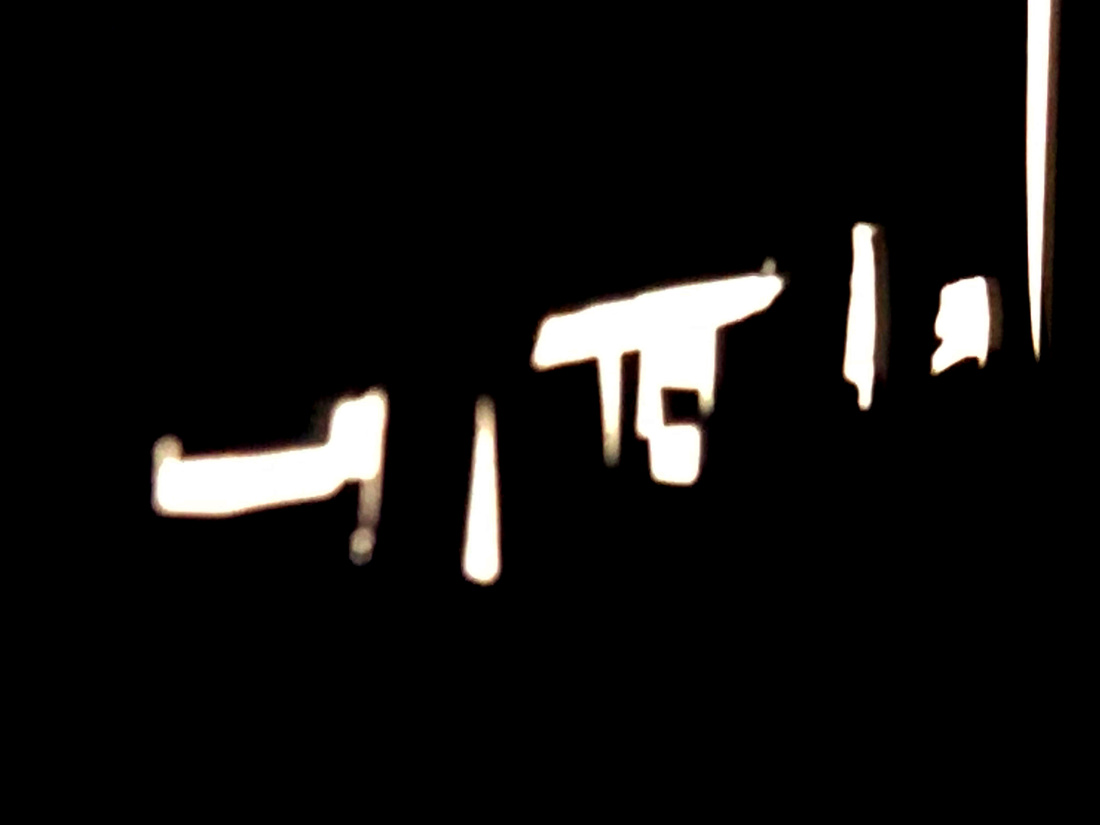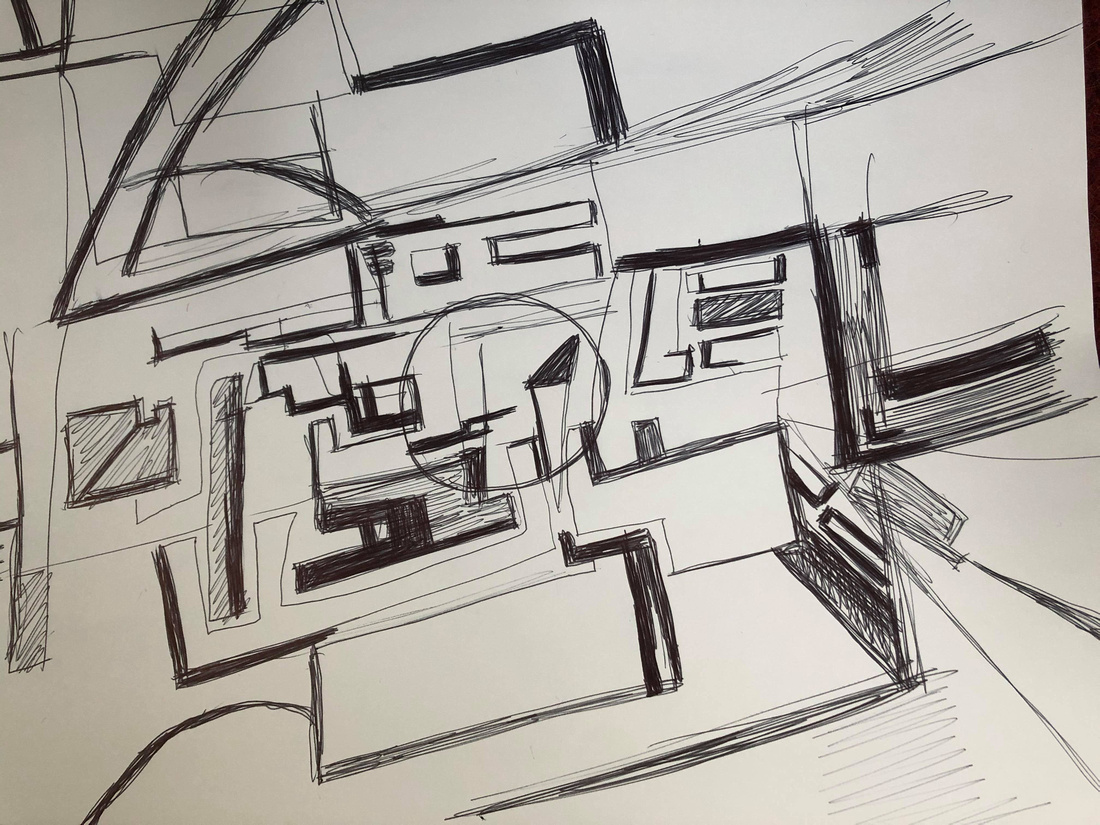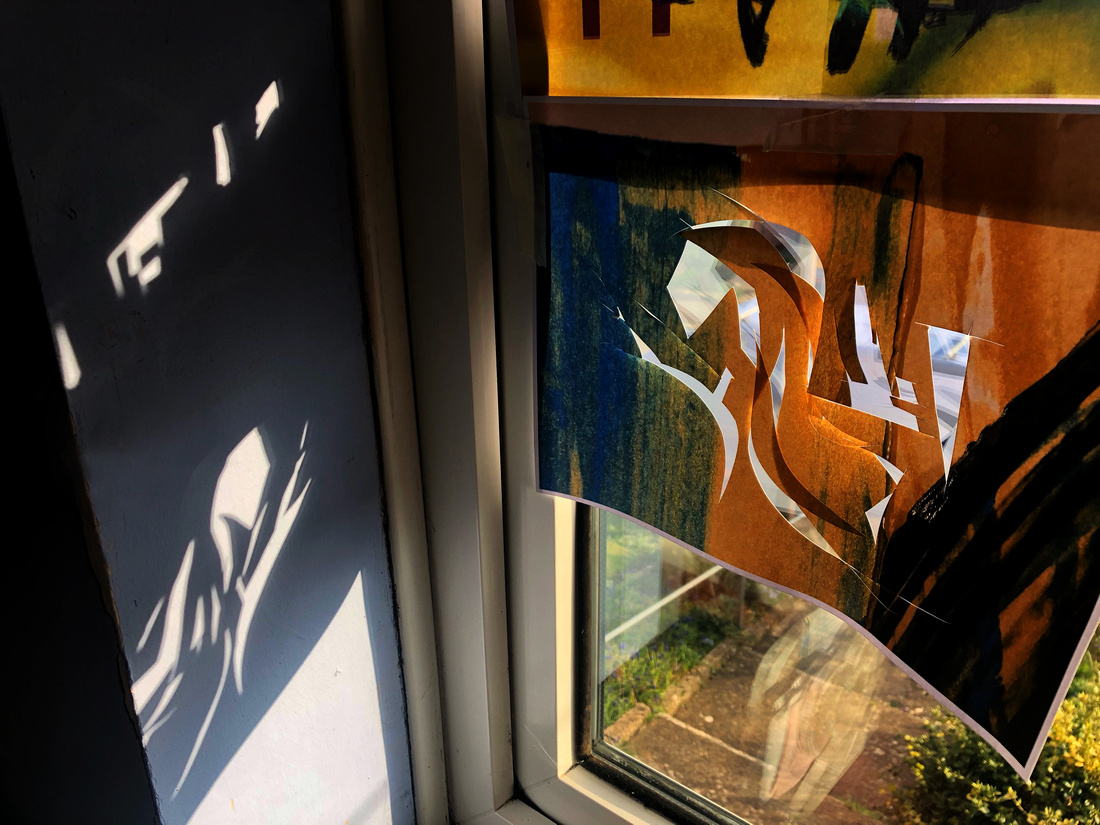Creative Concept Module - Research Journal and Information
Todays lecture saw us as a group present our personal briefs to the group as a whole.
Good feedback was received, and interesting points were raised. such as secondary mark making which I will look into and also the mixture between digital and hand crafted lettering and letter form. The use of specific papers like papyrus, and the fact that mark making on these types of papers is not curved but relatively straight in form.
How is technology changing the form of asemic writing, what is the shift? Asemic writing is for me found as much in nature as it is created through the digital world. What I have created so far is bringing together the hand produced with the digital layout. I guess the answers are why? To promote to a wider audience, everything is viewed and shared online, apart from us, we still live and function in a very different environment to our online worlds. So bringing communication into these environments I feel is the key to being able to subject the human to asemic writing fully. Asemic writing could be applied to everyday objects such as a mirror, or a door, things which we pass through to get to more focusd areas.
I spoke about the production of the hanging layout design which could be utilised into any environment to fill the environment with abstract writing, shadows and asemic writing as a whole. The layout will also be manipulated and having cut outs so that the light can come through and become isolated shadows on the walls and floors of any room applied to. Also by looking through the visual layout it isolates the outside environment. So there are many phases occurring here, transformation of the piece, isolation of the piece, and communication to the audience via straight on visual communication. True asemic art is the piece of art transforming to another asemic work of art a spiralling knock on effect from one to the other. Also using natural light as the source to create the secondary transformation through the cut out letterforms with the gigital layout once in situ.
Iterative design
The process of the experimentation of the cut outs within the layouts will be the next process to look at the produced shadows. iterative designed system is used as a form of research for informing and evolving a project. This is the way I wish to conduct the research by making and trial. I would also like to hang a prototype to see how by time lapse motion the light changes the design and how the shadows form on an internal surface.


^ First asemic digital layout, background images were utilised from the Creative Identity module, and arranged with vertical/horizontal lines to replicate asemic writing. (See Image Below) and used to create the layout, Yellow was chosen for its relationship to the sun, (source of light)
(The Color Yellow, 2021) https://www.empower-yourself-with-color-psychology.com/
States that.
"The color yellow relates to acquired knowledge. It is the color which resonates with the left or logic side of the brain stimulating our mental faculties and creating mental agility and perception.
Being the lightest hue of the spectrum, the color psychology of yellow is uplifting and illuminating, offering hope, happiness, cheerfulness and fun.
In the meaning of colors, yellow inspires original thought and inquisitivene

 ^ Above image - Asemic writing projection from original artwork ink onto glass
^ Above image - Asemic writing projection from original artwork ink onto glass
Experimentation with the first asemic layout, primitive cut out shapes were created in the design just enough to let light flow through to create asemic writing in the shadows. As the sun moved around gradually graphic shapes were formed on the inside of the window from the layout. These proved interesting enough to be able to utilise in a layout. See the transition below. Layering up into asemic sections joining each element added more abstraction, leading to the production of a graphic work.
Instead of saying "cut ups" the process needed to have a more integrated name. So after research I decided to use the word "Apposition" for its meaning of using one or more words, the placement of layering side by side, in a set pattern or juxtaposition the bringing together in placement or relationship with each other. The phase "Asemic Apposition" will be used to represent the removal of the negative space around the asemic writing in order to create new asemic writing from the shadow projections.

 ^ Projected asemic writing from the cut-up layouts, utilising negative space.
^ Projected asemic writing from the cut-up layouts, utilising negative space.

 ^ Projected asemic writing from the cut-up layouts, utilising negative space. (Contrast Adjustment in Photoshop)
^ Projected asemic writing from the cut-up layouts, utilising negative space. (Contrast Adjustment in Photoshop)


^ Projected asemic writing from the cut-up layouts, utilising negative space, diffused by cloud placement making the projection soft.

 I was then able to use these asemic letters to create the design below. By Duplicating, inverting and using a juxposition of layout, 3D abstractions became formed and new asemic writing created. By replicating the original reflection and manipulating these forms in photoshop. It developing altered perception was newly formed from the original artwork. Its my hope that some of these naturally produced shadows can become a base for the characters in Isiah's Experimental practice module. Particularly the dispersement of ink, and the fading in and out of these characters in the produced animation.
I was then able to use these asemic letters to create the design below. By Duplicating, inverting and using a juxposition of layout, 3D abstractions became formed and new asemic writing created. By replicating the original reflection and manipulating these forms in photoshop. It developing altered perception was newly formed from the original artwork. Its my hope that some of these naturally produced shadows can become a base for the characters in Isiah's Experimental practice module. Particularly the dispersement of ink, and the fading in and out of these characters in the produced animation.


^ Above image is a selection of collected asemic writing, from the projections made through the cut outs in the asemic layouts, removing the negative space with the layout gave way to the production of geometrically pleasing asemic writing, an inversion of the original shadow.
Focusing Out Experiment
Todays lecture saw the presentation of focusing in. Dr Pippa Galpin presented an exercise where we needed to collate a section of current work, and focus out of the parameters of this work. Focusing on the replication of asemic lettering forged from the shadows, the above abstraction became the focus within this exercise. What could be around the parameters of the shadows? Gradually using these creative concepts I conceptualised the possible extension of the above work. I could clearly visualise the piece, and worked out that the asemic shadows could be layered in depth, height, and perspective. The outcome of this was astonishing to me. The visual taking on the form of an above view of a New-York skyline. The other realisation in the work was that subconsciously I had created letter forms very clearly, manifesting the letters A, H, and the number 7. None of this intentional in the mapping out of this extension of image.

 ^ Sketches from the zooming out exercise.
^ Sketches from the zooming out exercise.

 ^ Sketches from the zooming out exercise.
^ Sketches from the zooming out exercise.


^ Projected asemic diffused by cloud placement making the projection soft, fusing out at the edges.


^ Above image "Asemic moon" is an example of asemic writing created by Susan Lloyd-Cowley (2021) hand crafted asemic calligraphy, assembled in Photoshop with geometric shapes. Inspired by the moonscape night projection.




^ Early morning transitional projection onto white paper.


^ Image above was dual alignment of layouts to collect asemic projections as a secondary exposed layout.

^ The above timelapse video shows how light trancends through the layouts and the removed empty space around the asemic writing. Taken over the time lapse of a 30 minute period mid afternoon.


^ The above image was taken utilising what light was being emitted by the moon at night. No editing was applied to this image. A clear blue hue, and the brightness highlighting specific areas within the layout. predominantly around the curved areas of the asemic shape. Using Optical Phenomena the interaction of the layout and the background subject of the moons natural occurring environmental light, whilst also utilising movement from the moon, night sky and clouds.


^ Moon Scape capture-1 - Asemic writing element captured via moonlight diffusing through the graphic template created from the trimming out of the empty space around the original asemic writing layout. These elements were fused together in photoshop so that the original projected elements could be used digitally.


^ Moon Scape capture-2 - Asemic writing element captured via moonlight diffusing through the graphic template created from the trimming out of the empty space around the original asemic writing layout. These elements were fused together in photoshop so that the original projected elements could be used digitally.

 Moon Scape capture 3 - asemic writing element captured via moonlight diffusing through the graphic template created from the trimming out of the empty space around the original asemic writing layout. These elements were fused together in photoshop so that the original projected elements could be used digitally.
Moon Scape capture 3 - asemic writing element captured via moonlight diffusing through the graphic template created from the trimming out of the empty space around the original asemic writing layout. These elements were fused together in photoshop so that the original projected elements could be used digitally.
Optical Art
Optical art is created by by the use of light, shape and the altering effect of how we relate to what we see. Optical Art collectively uses shapes, colours and patterns in abstract and ways, by the use of juxposition, overlaying of elements to give the effect that images are moving, blurring and sometimes merging into the environment.
Inspired by the works of Ellesworth Kelly.
"The negative is just as important as the positive.”
-Ellsworth Kelly
Ellesworth Kelly is an American artist, sculptor, and printmaker. He created geometric hard edged paintings. He studied light phenomena and was fascinated by shadows, abstraction. (May 31, 1923 – December 27, 2015) he was inspired by minimalism, and the later works of Monet. The Work below "Seine" was created by the his experiments into how light dispersed onto water.
The Youtube video below is Ellesworth Kelly describing his first interactions, and observations and how he was visually searching for abstraction.


^ Seine by Ellesworth Kelly - 1951. oil on wood.
https://ellsworthkelly.org/work/seine/
"The Japanese concept of Ma
The Power of the Space in Between - The Center for Transformational Presence In-text: (Seale, 2021)
(Seale, 2021) States that "The Japanese concept of Ma can help us understand the significance of the space in between. Ma can be described as empty space, as a gap between one thing and another, or as a pause within movement or flow.
Yet it’s much more than just empty space, a gap, or a pause. Ma does not actually describe a physical space created by objects, boundaries, or structures. Instead, Ma describes the essence of the energy or intention that is felt or experienced in that space.Ma is empty space that can be filled with any possibility. What you project into that space – an object, an intention, or an awareness or understanding – shapes the experience of anyone who enters into or engages with that space. You can intentionally infuse the space around or within a particular situation (the Ma) with a particular energy or consciousness"
Above quote can be found at Seale, b., 2021. The Power of the Space in Between - The Center for Transformational Presence. [online] The Center for Transformational Presence. Available at: <https://transformationalpresence.org/alan-seale-blog/the-space-in-between/> [Accessed 10 April 2021].
Julio Le Parc
Born 1928
Argentinian artist, inspired by the works of Mondrian and the movement of Constructivism.
Parc worked in three dimensions, utilising movement and light. He incorporated projected, moving or reflection of light into his work.
‘Categories, in general, are reductive. I would prefer to be classified as an experimentalist’ Julio Le Parc


^ Continuel Mobile Lumière - 1958
lacquered metal, nylon string, aluminum, lacquered plywood and lightbulbs






^ Structualist Practitioner Quotations
 ^ Above - Time Lapse layout inversion from day to night, focusing in on negative space, line, shape. Drawing out new asemic writing exploration. How the form adjusts to light over a period of time. 2 Hour time lapse experiment.
^ Above - Time Lapse layout inversion from day to night, focusing in on negative space, line, shape. Drawing out new asemic writing exploration. How the form adjusts to light over a period of time. 2 Hour time lapse experiment.


^ Still frame showing transitional change through the time lapse capture.

 ^ Still frame showing transitional change through the time lapse capture.
^ Still frame showing transitional change through the time lapse capture.




^ Image Above - Shadows capture created from projected artwork placed on to window during midday sunlight. Creating diffused, and heavily dark and contrasting elements of form.


^ Image Above - Photographic capture from asemic writing on acetate hung via a wooden frame in outside woodland environment.


^ Image Above - Removing the space around asemic writing to create new elements for projection capture. Camera perspective looking through to the environment beyond. To utilise different and angles and environment.


^ Image Above - Woodland setup as used in the Experimental Practice module. Elements from these projections and captures through the acetate have been utilised as backdrop images behind the asemic shadow captures.


^ Image Above "Emmergence21" The above image is the result of utilising the projected shadows created from cutting and removal of the negative space around the asemic writing layouts, and using natural daylight to create shadows onto white paper while being suspended in a clear glass window pane. This has then been duplicated to create a character like presence and visual interaction with the background image which was created by hanging asemic writing within the natural environment there is clear visual form of trees and branches. The inspiration and impact of nature is my work has become obvious during these experiments as well as the utilisation of environment and light as a medium of art in its own right. The combination of these elements has created new asemic communication and abstraction. This has created a new outcome in terms of practical experimentation, and the elements of light diffusion captured through the projections
and a combination of moonlight, bright contrasting sunlight, diffused light and overlapping contrasting elements of light. Which have then been collated and placed together digitally. It is in Philosophy that emergentism is the belief in emmergence as this involves the consciousness and philosophy of the human mind. Objects are said to be emergent a new outcome of some other properties are revealed their interaction, while it is itself different from them
EMERGENT DUALISM: Human beings are no way identical to any other human or human physical body, as a human we consist. of a physical body and a non-physical human soul, our individual human soul is naturally emergent from and dependent on the structure and function of a living human brain and nervous system as well as our interaction and diversity and inclusion of self into our environments.
Ernest Weber - Webers Law on Perception
Weber determined that there was a threshold of sensation that must be processed by the brain before any prominent escalation in the intensity of the original visual stimulus could be recognised. Weber described a number of his experiments in this area in De Tactu (1834; “Concerning Touch”)
Weber experimented in touch and tactile sensations, between two points of touch on the skin, where a person can perceive two separate touches.
So in relation to my experiments of utilising natural light to create new asemic characters the relationship with the variable intensity in the shift of light becomes the important factor. Also our personal everyday experience with natural light is a key relationship with from a human perspective, and sensory experience, natural light is not new to us, but to establish a communication with it from the collation of asemic writing projection in this experiment is.
Michal Rovner
"I always start with reality, in anything I do, everything I do, I always start from something real".
"I go back to [the idea] that we are avoiding all of these unknowns, we're avoiding the night - most of us - we're avoiding the encounters, but we're also afraid to deal with something unknown, unseen".
The Israeli Artist is most well known for her projections of people onto stone, and in environments such as factories and coal mines. Rovner addresses the concept of time passing us all by, and how we leave our mark on the world. In the clip above Rovner talks about her work and how she creates imagery from cutting around the initial image, she uses the outline of the object to create the primary focus for her work. I found this to be very simular to the work I was creating from the shadows in the asemic cut-outs by utilising the negative space in the writing to create new object, and form and a new asemic writing in the process.
The element of time in my practical research has also been an element which I need to research further. How light changes with each passing second, how it is filtered and broken down by objects as well as the human eye, Optical phenomena, and the effects of light through objects and how time changes these instances although fractionally. The effects of the time lapses when they are overlayed there is a clear interaction and subtle change in appearance and how we judge these changes with our instinct and visual perception.
According to Roland Barthes.
According to Barthes anything which we encounter as a human can be a sign that triggers and relays a message to us in an individual sense as well as a collective sense. Myth in our cultures convert our human realities into speech based communication based on experience as well as our senses.
An example of a sign would be the colour black, which to the many would signify grief and death, or a white feather would signify hope, or a sign that an angel has passed our footsteps.
Signifiers
Signifiers would be for us to us form the sound of something like the word Tree for example, we would then have an image of a green tall tree, often surrounded by other trees in nature, with wildlife, plants at the trees feet.
Signals
Signals are the transfers of meaning, they grab our attention like smoke, or a loud scream, they often change an environmental element.
Signs
Signs are the are the pictures that surround us, drawings, art, we observe signs through all forms of life. They convey message, in all cultures, Signs can be changed in meaning by colour, size, environmental setting, form, material, human or animal.
Symbols
Symbols are individually and personally recognised, they are grown and expanded by the original viewers perception of life and the world around them, anything that they have touched and had experience with in their lifetime. In the experience of the new asemic writing this is a good example of a symbol that could be evolved to something new by the germination f the human experience. The abstraction and reading of the asemic writing is then converted to a new meaning by the viewer. The involvement of light, time, diffusion and elements of familiarity will be germinated by individual processing depending on the signal, sign, and symbol. If the colour can be added to change the asemic writing or several colours can be added to the asemic writing this will add a sign to the observer. Allowing them to associate with the new asemic alphabet, adding signs to the newly formed asemic alphabet and the research and principles of how Semiotics and Semantic theory work will be important foundation stone as I research and construct the practical elements for the practical development within the Independent Project next semester.
Moving Forward- Independent Project
The definitive plan for the independent project will be to take all of the experimentation from the Creative Identity Module, and also the Creative Concept module and combine the elements of light, evolution of light from the time-lapse videos, shadow and asemic writing and combine these elements whilst utilising the theory of semiotics, semantics and structuralism to create an asemic alphabet.
Having researched the symbolic work of Yukio Ota who famously designed the emergency exit symbol, dedicated his life to the creation of symbols but focuses in on the creation of an entire language made entirely out of symbols. One universal language for all cultural and ethnic groups of people all around the world.
The production planning for the independent project will take on the form of research by the use of enquiry from people in all social circles, looking at people from specific areas who have autism, deafness, and people who also have no cognitive impairment. I will trial the asemic alphabet and receive feedback from these enquiries in the form of a visual questionnaire. prompting questions of what the writing is suggesting in terms of communication, and how it makes them feel. The asemic alphabet will be a variation on the pure black print which we are used to viewing in society, it will contain elements of exploration in light.
This module and colour will carry these light and dark themes throughout as well as emphasis on the negative space around the form. Utilising the visual perceptive senses of many people and generating feedback from these explorations. Light has an intrinsic effect on how we process information, many humans are caught staring out of a window pondering the vastness of the sky and watching the clouds roll by, or needing to take a walk in the fresh air to clear our minds.
A well designed learning environment and a symbolic alphabet which contains semiotic traces, and elements of light may tune focus, and enquiry from the observer. Through the design process, research and practical experimentation and enquiry that I will carry this process on in to the independent project. I will further develop my research in to the movement of Abstract Expressionism, as I feel this will further my knowledge into my gestural and emotional mark making with its spontaneity. This will further lay the foundations in the creation of a symbolic asemic alphabet in the independent project.